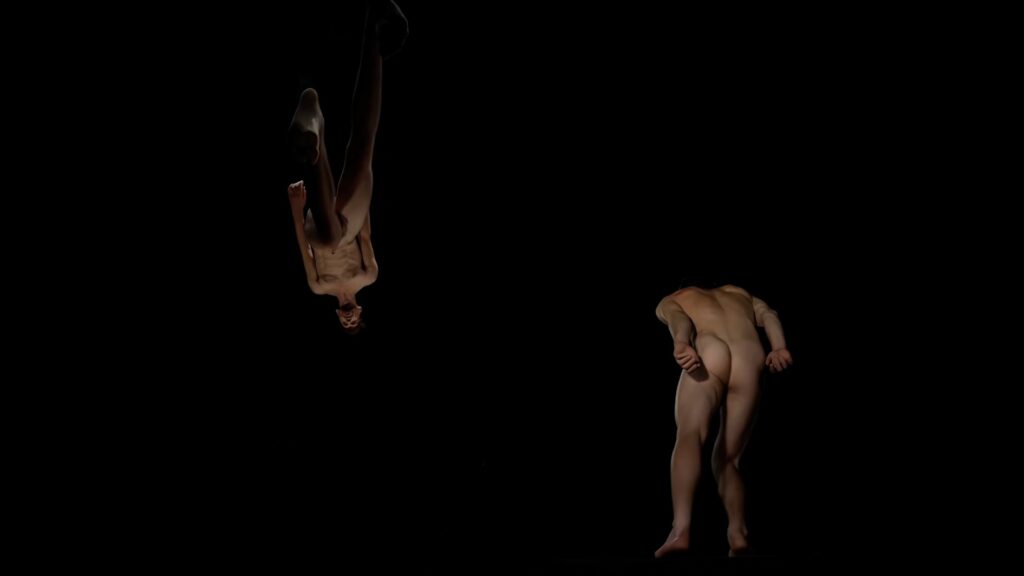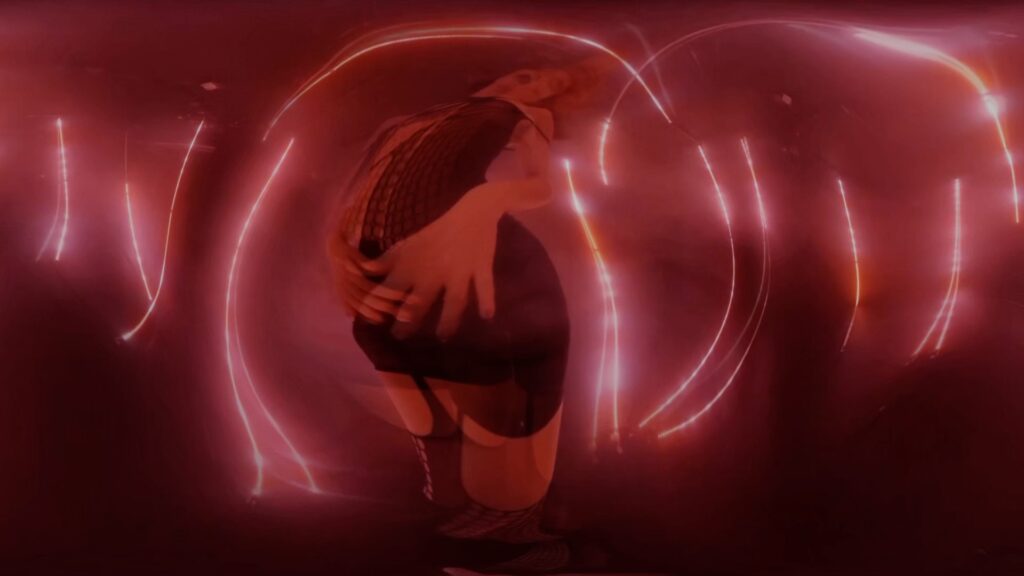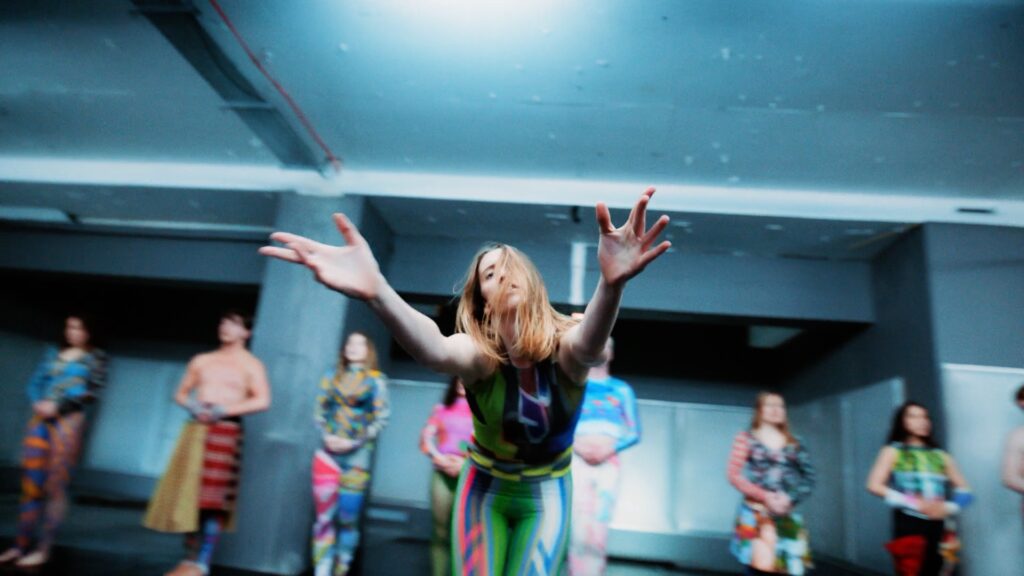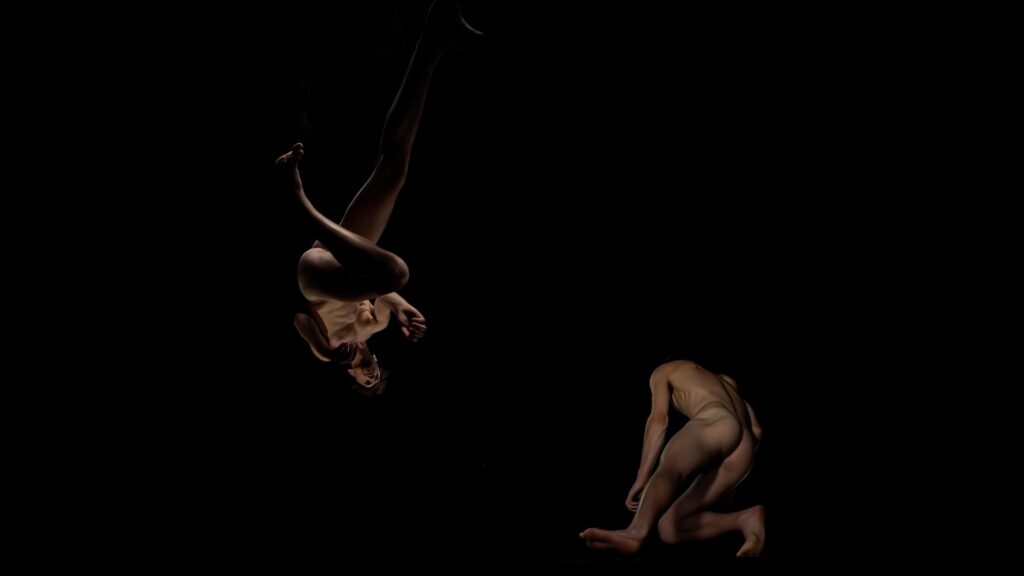Fact Residency: Theresa Baumgartner

Theresa Baumgartner channels painterly sensibilities and the unbridled energy of experimental music across a variety of disciplines, blurring the lines between installation art, audiovisual performance and experimental film.
When Theresa Baumgartner was at studying at art school, prior to her transition into audiovisual art, she became obsessed with making paintings on a huge scale, so huge, in fact, that by the artist’s own admission they worked just as well as sculptures as they did paintings. By the time she had completed her studies Baumgartner was disenfranchised with the world of fine art and found herself gravitating towards the visceral energy and emotional chaos of the experimental noise and punk shows of her youth. Seeking a more democratic space for her practice, she has ploughed her own furrow, oscillating between installation work, live performance and art film, yet these two formative experiences of painting and punk have continued to inform all of her work.
Whether fucking with the male gaze alongside artist Abyss X, reflecting on defeat and failure with musician Sam Slater, submerging us in the sounds of oceanic noise pollution with field recordist and Cabaret Voltaire member Chris Watson or translating the sonic disruption of producer Muqata’a into textural, painterly visuals, Theresa Baumgartner draws from her experience to imbue her work with emotional potency. As she levels: “I’m more interested in the emotional part in anything. At the end of the day I’d rather have people reaching back into themselves, being overwhelmed or just able to forget about themselves.”
Theresa Baumgartner Presents: Abyss X – Animosity (SOPHIE Remix)
“Surrounding yourself with your friends is influential because you throw ideas around that boil in everyone’s head,” Baumgartner emphasises. “I understand how scenes develop and evolve because you all sit in the same stewing pot.” Contributing to festivals like Berlin Atonal and CTM and heading up lighting design and visuals for Berlin’s pioneering audiovisual space Trauma Bar Und Kino, the artist has been able to move among a wealth of world class talent, drawing inspiration from a plethora of artists and collectives. It was in this way that Baumgartner’s collaboration with Hellenic experimental taste-maker Evangelia Lachianina, otherwise known as Abyss X, developed. “I started talking to Evangelia about this idea for a 360-degree camera and a light installation that I’ve been wanting to play with for a long time,” she explains. “I wanted to have something that was high energy and doesn’t really give a fuck, to let out some steam and make it weird.” Transposing 360-degree footage into a single channel, Baumgartner captures Abyss X at her most distorted, seemingly trapped in an illuminated chamber, moving in a ritualistic fervour to the sounds of SOPHIE’s shape-shifting remix of her own track ‘Animosity’.
“I’m fucking with the male gaze,” says Baumgartner. “There are clear symbols that this is supposed to be attractive, but then I’m morphing her body, morphing her features.” It’s here that the artist’s DIY influences are most apparent. Everything from the visceral performance of Abyss X, the sparse lighting and smoke to the asymmetry of Baumgartner’s frame, her disregard for convention and perfection, imbue the piece with subterranean potency, like you’ve just stumbled across two friends testing their artistic limits in a cramped Berlin basement. “I’m okay with things looking rough, or disorganized and turning that into a statement,” she says. “With stage design especially, often everything’s symmetrical and super slick. I’m okay with it really not being that way, to a degree where I’m really going the other way.” Encouraging each other to push their respective practices further, Theresa Baumgartner builds a world for Abyss X to inhabit, imperfectly and unashamedly.
This kind of world building stems from broader world view that was shared in part by their third, sadly absent collaborator. “The collaboration is basically a tribute to SOPHIE,” explains Baumgartner. “Her production works really well on a technical level, it’s artificial and highly produced, so blending it with the 360 technology fucks that up again. It’s out there, technologically, but then it breaks it, and that is also what SOPHIE did with her music.” Through both sound and image, SOPHIE demonstrated that it was possible to find a pureness of expression and an emotional truth in the most artificial, technologically-mediated places. Through digital distortion and physical theatrics, Theresa Baumgartner and Abyss X pick up this thread, injecting DIY energy into audiovisual art and performance.
Theresa Baumgartner Presents: Vandals (Excerpt)
I do not wish to be known as a Vandal is a 40-minute, audiovisual installation work from musician Sam Slater, performer Lukas Malkowski and this month’s Fact Resident, artist Theresa Baumgartner. Spanning 40 minutes in length in its original iteration, above Baumgartner presents Vandals, a short excerpt of the stunning film that functions as a moving image metaphor for failure, pain and resolve in the face of both. Captured in ultra slow motion with four high speed cameras, the work follows Malkowski, standing naked, falling on his face before picking himself up and returning to his original position. “It’s about defeat and failure, like seeing a car crash in slow motion, watching someone falling, watching the point of no return and then hurting themselves by falling on their face,” explains Baumgartner. “But it’s also watching the rebuild process, returning to point zero again, very slowly.” Slowed to a barely perceptible crawl, through a process of A.I.-enabled upscaling each frame of the film takes on the quality of a Caravaggio oil painting, each second of chiaroscuro amplified in a moving portrait.
“It has this tragi-comedy, Buster Keaton quality, or like one of Samuel Beckett’s characters,” says Baumgartner of Vandals. “It’s absurd and it’s painful, but it’s also essential. Failure is essential in terms of your own practice, you have to be okay with really fucking up.” Originally paired with the new album of the same name from Sam Slater, who collaborated with Hildur Guðnadóttir on her Grammy-winning soundtrack for Chernobyl and her Oscar-winning score for Joker and was the sound designer for the late Jóhan Jóhansson, the excerpt presented above is set against an original composition from Slater. “It is the soundtrack to falling uncontrollably in ultra slow motion; an event happening too fast to control, displayed as a barely moving image,” describes the artist. “It is a simple visual image which speaks to moments of personal and social collapse and recovery, and the repetition of this arc. The music traces this form, ending where it starts, creating a simple audiovisual cycle – in which all things break and something is made from the mess.”
In this sense, Vandals is representative of Baumgartner’s ability to work across different techniques and varying scales, from the largest and most complex to the smallest and simplest. “I like when things are quite minimal,” she says. “It’s one statement. It’s one gesture and it’s quite easily understood, but then by stretching it out for that long and making it 40 minutes, there’s a lot of story in a lot of nothing.” As an installation, both angles of I do not wish to be known as a Vandal will be reflected on each side of a freestanding screen, allowing the audience to move around the depiction of the fall at their own pace, lending real-time movement to the ultra slow scene. What ever sorts of personal or communal failure the viewer maps onto the piece, ultimately what it depicts is a bleak sort of optimism.
Theresa Baumgartner Presents: Seaphony
For Seaphony, artist Theresa Baumgartner reunites with David Attenborough field recordist, sound designer and Cabaret Voltaire founder Chris Watson to create an immersive, audiovisual representation of the alien soundscapes of the ocean floor. “Chris was approached by Oceans 21, an NGO trying to raise awareness about noise pollution in the oceans, which is a huge problem that kills sea creatures,” explains Baumgartner. “Ship traffic, oil drilling, military radar are all really stressful for the animals because after about 100 meters down into the ocean there’s complete darkness, hearing is the main form of communication.” During an expedition to record blue whales in the Sea of Cortez in Baja, California, Watson and fellow field recorder Tony Myatt captured a stunning collection of recordings of not only marine life, but the rupture of these natural environments by human hands. Describing earth’s oceans as “the largest and most sonorous habitat on our planet,” Watson stitches together the recordings captured with Myatt into an hour-long audio piece, simulating the sounds of the deep.
This composition will form the sonic backbone of Seaphony, an installation that will feature three-dimensional ambisonics, courtesy of Tony Myatt, as well as lighting and sculpture from Baumgartner. “The visual effects that we see in the teaser is just a zoom-in on custom light fixtures that I built, which are four-meter-high columns with an LED core,” she describes. “They create this really beautiful, ice melting, glacier effect. I’ll have eight of them in the room and then the whole room will be covered with mirror foil. I wanted to try and disturb the sense of space as much as possible by having a mirror floor, you don’t really know when the room ends and where it starts. The dimensions create this ocean vastness.” Condensed into a single channel, Seaphony takes on a painterly aspect, translating the light, shade and colour of the ocean viewed underwater into a gently warping picture that gestures as much towards Watson and Myatt’s field work as it does Baumgartner’s own background in painting.
“This is something that is quite easily fixed,” she emphasises. “You can build noise barrier walls that would make the ocean way quieter. You could put noise fences around oil platforms or have seaways where there are a lot of fish and sea mammal populations. There are ways to fix it that wouldn’t be so hard to attain.” Plunging her audience into an audiovisual representation of these conditions is a natural extension of Baumgartner’s democratic approach to her art practice. As opposed to keeping her meaning and message concealed by concept and aesthetic, Baumgartner, Watson and Myatt allow us to experience the issue instinctually, providing us with the space to be submerged in sound.
Theresa Baumgartner Presents: Muqata’a – Quboor Mamila قُبور مَاميلا
Theresa Baumgartner met Palestinian underground hip-hop pioneer Muqata’a back in 2018, when she was filming on location in the city of Ramallah in the West Bank, Palestine, for the Boiler Room documentary Palestine Underground. The DJ and producer has become legendary for his unique approach to sampling and looping, which he has developed into a practice which is at once musical and political. “When our land is being taken away, our culture is muted,” he told The Guardian around the time of the release of the documentary. “It’s a way to try and disrupt that – being a glitch in the system is very important. When your heritage is being attacked by the state, you have to find ways of being remembered, so I sample a lot.” Incorporating classical Arabic music, old records reclaimed from his grandparents’ collections and field recordings of Israeli military checkpoints into his compositions, Muqata’a fashions dense and detailed audio portraits of cultural and societal disruption, a project which is invoked by his moniker, which can be translated as “disruption,” “interference,” or “boycott.” It was the intricacy of Muqata’a’s method that initially drew Baumgartner to his music. “Muqata’a has a very special way of using field recordings,” she says, “there’s a lot of texture in his music.”
It’s this texture that Baumgartner zeroes in on for her visual treatment to the producer’s track ‘Quboor Mamila قُبور مَاميلا’, an opening salvo of sinister ambiance, skittering samples and frazzled noise that sets the scene for his new album for Hundebiss, Kamil Manqus كَامِل مَنْقوص. Drawing from her background in painting, Baumgartner layers digitally manipulated images into gauzy, textural vignettes that pulse and flicker to Muqata’s sounds. “It’s the painter coming out of me, but just adding the factor of time to it,” she explains. “Playing with colors and textures, that slow dripping movement. Older versions of the visuals actually stemmed from an obsession with deserts. On Google Maps I would fly over different deserts like the Gobi Desert and the Kalahari and it’s insanely beautiful what those satellite images spit out. With the photos being shot at different times of day, how the sun hits the surface changes, so there’s mistakes in the images. It’s gorgeous, it looks really weird.” Shreds of digital interference and pixelated feedback obscure the artist’s source material beyond recognition, meeting Muqata’a’s sonic disruption with her own audiovisual variant.
“I manipulate the footage in different ways,” continues Baumgartner. “The newer ones are partly the desert satellite images, as well as drone shots and footage ran through an old tube telly and then re-filmed. There’s a lot of procedure in it, it’s a bit like a ’70s special effects workshop, experimenting with analog stuff and seeing what happens.” Fusing a selection of these experiments together in a shifting sequence, the artist found inspiration from the structure of short story collections, specifically Olga Tokarczuk’s Flights. “These short little moments give you more of a hint to the story than just building the whole thing,” she says. “This works across different projects. You make something, but then the actual work happens in the head of the viewer – what people take from it, how people experience it and how it makes them feel. You make a proposition, throw something on the table, and then people take away from it what they want, or what they don’t want. It’s a way of talking to each other.” In this way, Baumgartner enacts an dialogue between two complementary art practices, the politicised patchwork of Muqata’a’s samples and loops drawing out the painterly energies of Baumgartner’s DIY visuals as the artist translates the producer’s aesthetics of disruption into evocative visual forms.
For more information about Theresa Baumgartner and her work, you can visit her website and follow her on Instagram.
Watch next: Fact Residency – Actual Objects
The post Fact Residency: Theresa Baumgartner appeared first on Fact Magazine.
Link to the source article – https://www.factmag.com/2021/12/11/fact-residency-theresa-baumgartner/
Recommended for you
-
Pop Back Vocal – Large unique 24bit WAVE/KONTAKT Multi-Layer Studio Samples Production Library
$14,99 Buy From Amazon -
CarolBrass CTB-1005-YSS-L Mini Trombone, Slide Bb Trumpet
$0,00 Buy From Amazon -
Fever 2411-1-L Deluxe Alto Horn Lacquer
$0,00 Buy From Amazon -
UMOMO UMO-713 88 Key Weighted Keyboard Piano with Thick Triangular Metal Stand, Beginner Digital Piano Full Size Heavy Hammer Weighted Action Electric Piano Keyboard with MIDI, Black
$299,99 Buy From Amazon -
Kalymi Music Mandolin Chords and Fretboard Poster Set
$18,99 Buy From Amazon -
Caattiilaa USB Microphone – Professional Recording Microphone, 192KHZ/24Bit, Pop Filter, Boom Arm Set, Easy Installation, Compatible with PC, Laptop, Mobile
$59,99 Buy From Amazon -
Roland GA-FC Foot Controller for GA-112 and GA-212
Buy From Amazon -
Cornet 3 Valve, BB Pitch, Premium Quality Including Mouthpiece and Carry Case. (BRASS)
$129,00 Buy From Amazon













Responses